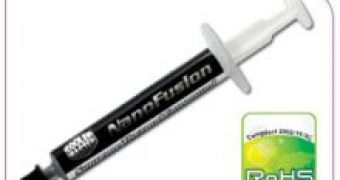Being a true innovator in providing PC thermal solution, Cooler Master considers every aspect of cooling, including providing the best solution for a small air gap.
NanoFusion - the revolutionary thermal grease compound newly released by Cooler Master - surpasses every overclocker's expectation in terms of its Bond Line Thickness (BLT), Thermal Conductivity, Thermal Resistance and Specific Gravity. With the accomplished 0.019mm BLT, NanoFusion has successfully minimized thermal resistance to 0.065 ?J -cm 2/w @ 40psi, which has been proven to be unmatched by any other thermal grease in the market.
Besides providing the best performance, NanoFusion is also environmentally safe, meeting the increasing demand of RoHS requirements. In addition, NanoFusion is comprised of non-electrical conductive material, to prevent system short circuitry. NanoFusion is definitely a crucial component to your precious system that any overclockers cannot miss.
Thermal grease (also called Thermal compound or Thermal paste) is a substance used to help the conduction of heat between two (usually metal) surfaces. It is often used to aid the thermal dissipation of central processing units via a heat sink. A heat sink is an environment or object capable of absorbing heat from another object with which it is in thermal contact. In common use, it is a device made of metal brought into contact with the hot surface of a component, such as a microprocessor chip in order to stabilize its temperature through increased thermal mass and heat dissipation. In most cases, some kind of thermal interface material is put between the heat sink and the heat source to increase thermal throughput - thermally conductive grease is employed to ensure the best thermal contact. A good heat sink is vital to overclocked computer systems because the cooler a microprocessor is, the faster it can be made to run without instability.
There are several types of thermal grease: 1) Silicone-based thermal grease has moderate thermal conductivity, is usually white, and is often shipped with heatsinks. 2) Ceramic-based thermal grease contains ceramic particles suspended in other thermally conductive ingredients. Ceramic thermal grease conducts heat better than most silicone greases, but poorer than metal greases. 3) Metal-based thermal grease contains metal particles (usually silver) and other conductive ingredients. Metal thermal grease has a better thermal conductivity (and is more expensive than silicone-based grease). Thermal grease's primary purpose in computing is to substitute for the constructional imperfections of a heatsink's surface. When applied in appropriate quantities, it fills the tiny pits and grooves (on the CPU), thereby increasing the amount of surface-to-surface contact with the CPU dye.

 14 DAY TRIAL //
14 DAY TRIAL // 
